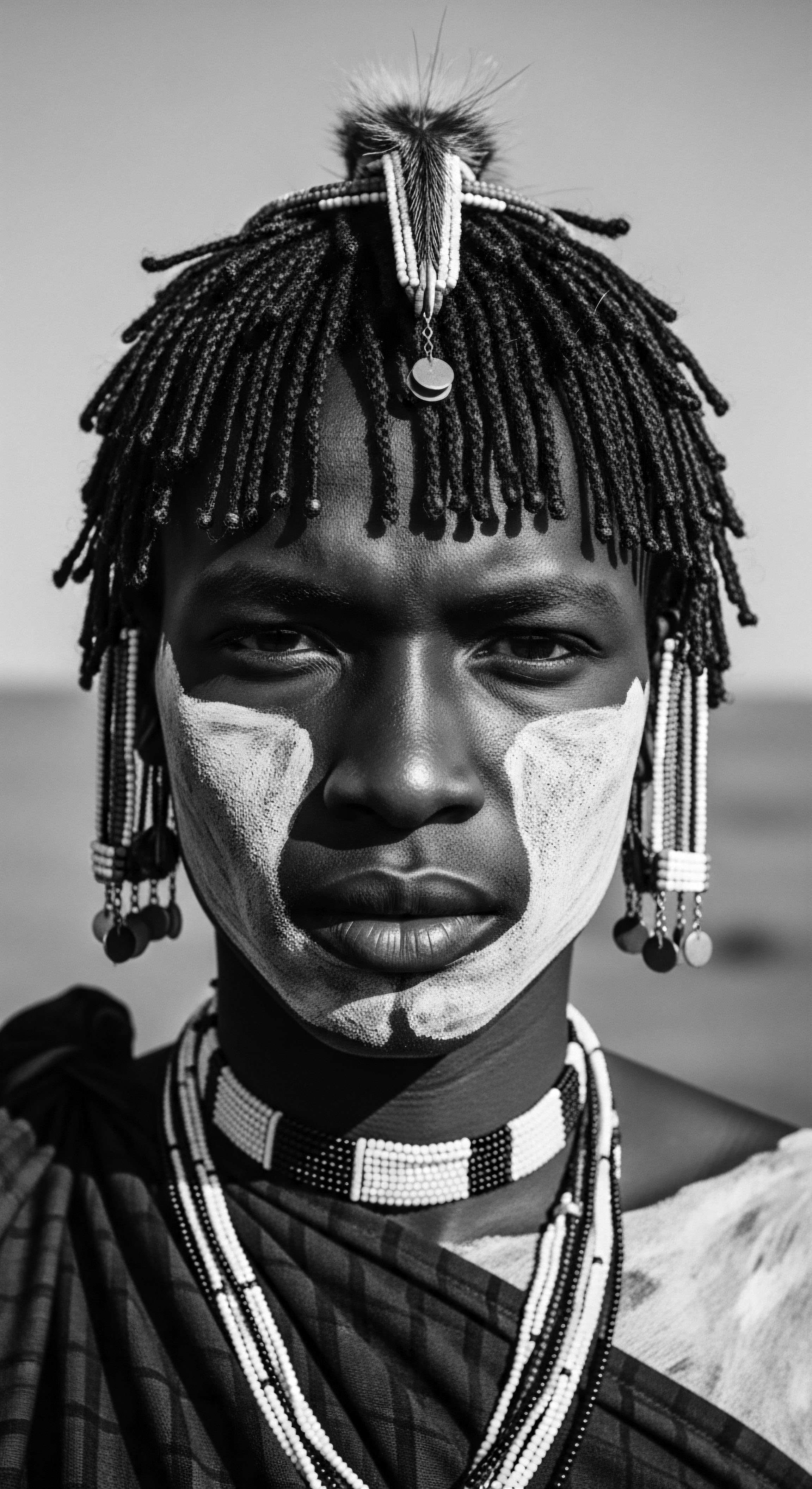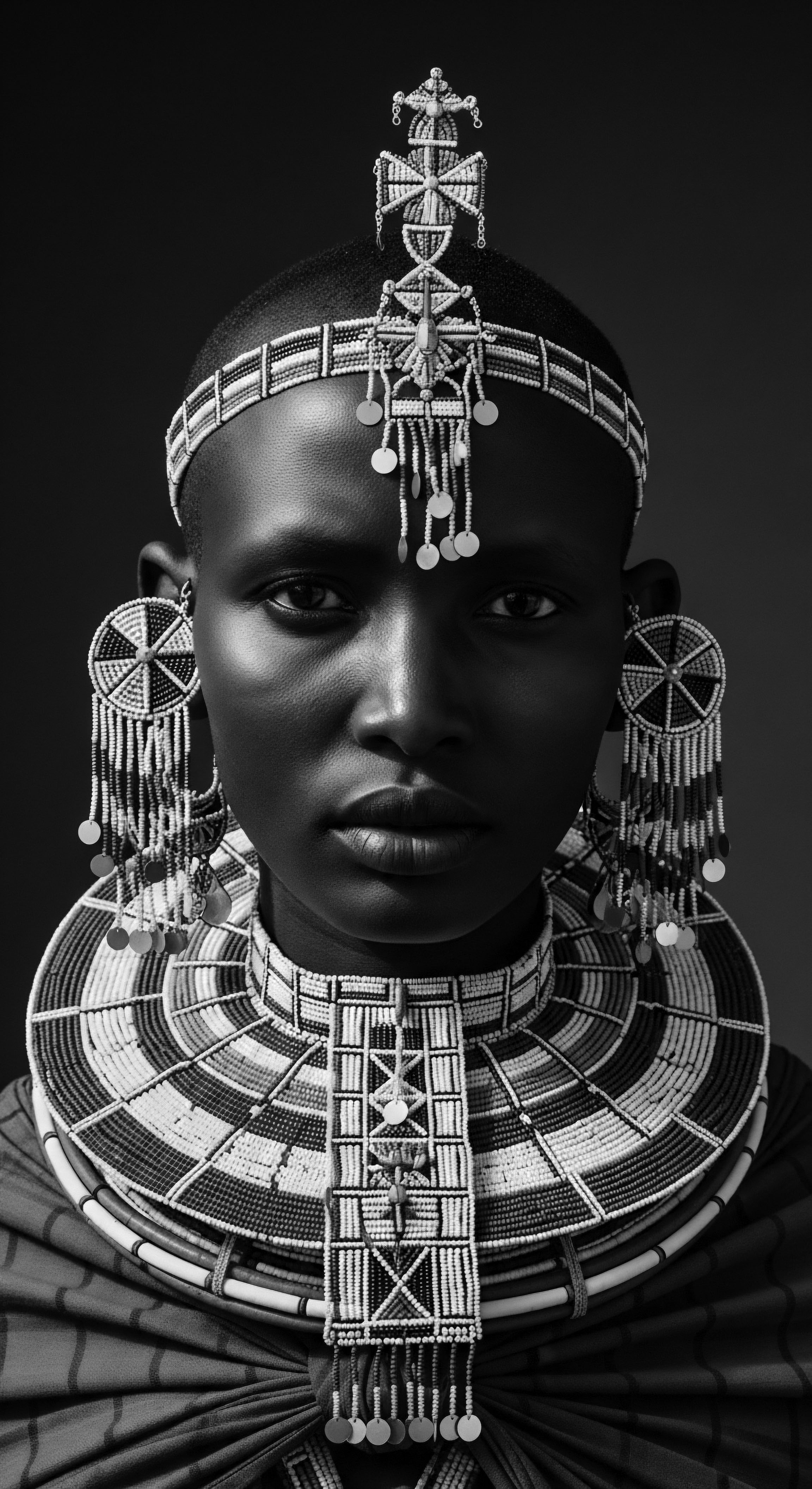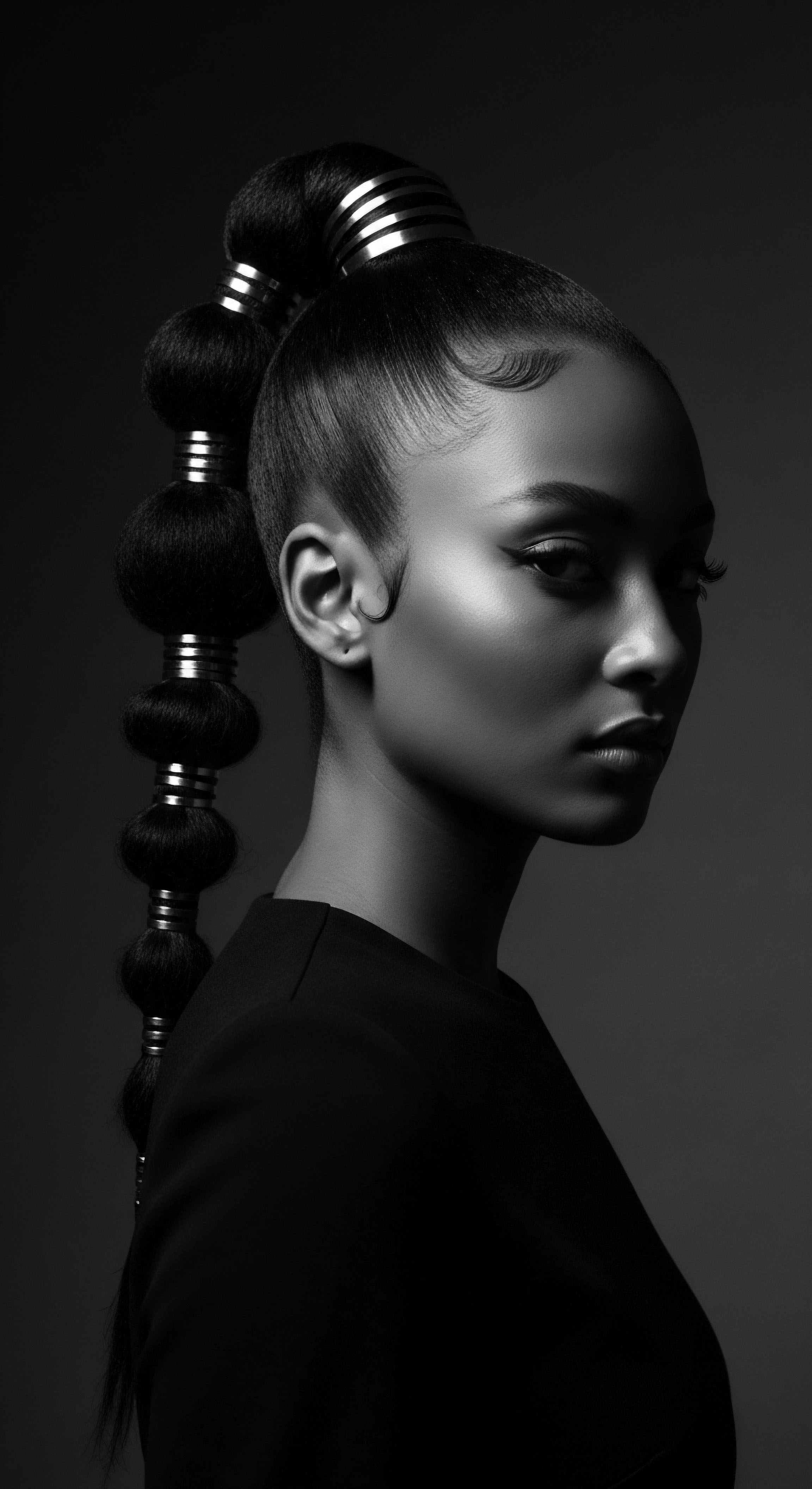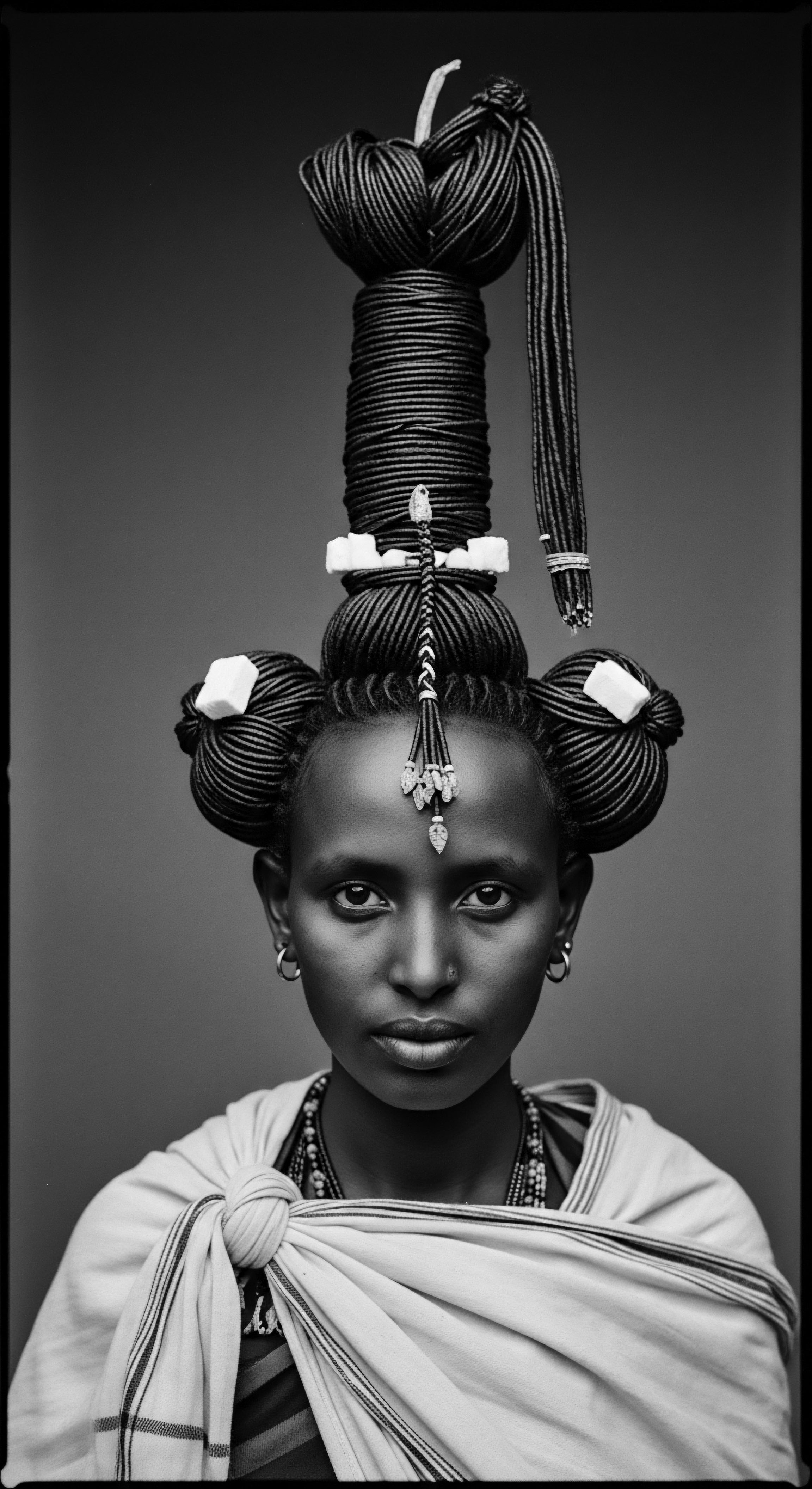
Fundamentals
The concept of Yoruba Dyeing, when considered within the intricate tapestry of hair heritage, points to more than a mere alteration of color. It denotes a profound traditional practice deeply rooted in the cultural, spiritual, and aesthetic values of the Yoruba people of West Africa. This encompasses the meticulous preparation and application of natural pigments, primarily derived from plants, to adorn and care for textured hair. At its core, Yoruba Dyeing is a statement, a deliberate act of cultural continuity, reflecting ancestral knowledge of the earth’s bounties.
This practice is an ancient articulation of personal and communal identity. It represents an understanding of how our physical selves, particularly our hair, connect us to a larger spiritual and historical lineage. The substances employed, such as the vibrant indigo from the elu plant or the warm tones of henna from ewe laali, were not chosen by chance.
Their selection arose from generations of observation, experimentation, and a reverence for the properties inherent in nature. Each application carried with it layers of significance, whether for beautification, spiritual protection, or signaling social standing.

Early Manifestations of Pigment on Hair
From ancient times, the Yoruba utilized botanical gifts to imbue hair with color and vitality. These initial applications, long before the advent of synthetic alternatives, were inherently holistic. Pigments offered aesthetic enhancement while also serving as agents of wellness.
For instance, the deep blue obtained from the indigo plant ( Lonchocarpus cyanescens ), often known as elu, found its way onto hair as a dye. The knowledge passed down through generations indicated that indigo powder offered benefits extending to dandruff prevention and soothing scalp conditions.
Yoruba Dyeing stands as a vibrant testament to ancestral ingenuity, where hair color became a language of identity and a conduit for well-being.
Another foundational dye in the Yoruba tradition is derived from the Lawsonia inermis plant, universally recognized as henna, or ewe laali in Yoruba. The leaves of this plant were traditionally ground into a paste, not solely for intricate body art, but as a natural dye for hair and skin. This application went beyond cosmetic appeal, intertwining with cultural rituals and ceremonies, offering strengthening properties for hair and promoting scalp health. The very act of preparing these dyes involved an intimate connection with the natural world, a process steeped in communal engagement and the quiet transmission of skills.

The Sacred Canopy of Hair
Within Yoruba cosmology, the head, or orí, holds profound spiritual importance. It is considered the seat of one’s destiny, a personal deity that guides an individual’s journey through life. Hair, as the crowning glory of the orí, therefore held a particularly sacred status. It was not perceived as mere biological growth, but as an active medium, a conduit for spiritual energy, linking individuals to their ancestors and the divine.
The intentional application of natural dyes to hair became an act of honoring the orí, a protective ritual, and a visual declaration of one’s inner and outer self. This deep cultural reverence for hair meant that its adornment, including dyeing, was never taken lightly. It reflected an understanding that how one presented their hair was a reflection of their spiritual alignment, their social standing, and their adherence to community values.
This deep-seated reverence for hair and the head is clearly articulated in Yoruba aesthetic philosophy. The head receives special aesthetic attention because of its spiritual and biological importance. The choices of color and style were far from arbitrary, instead conveying layered meanings about a person’s life stage, social role, and even spiritual affiliations.
- Elu (Indigo) ❉ Derived from the indigo plant, yielding deep blues. Historically used not only for textiles but also for hair, offering benefits like dandruff prevention and scalp soothing.
- Ewe Laali (Henna) ❉ From the henna plant, providing reddish-orange hues. Applied for both hair and skin, playing a role in cultural rituals and strengthening hair.
- Other Botanical Pigments ❉ Various other plants, though less documented for hair dyeing specifically, contributed to a spectrum of natural colorants for diverse purposes, hinting at a broader botanical knowledge base.

Intermediate
Moving beyond the foundational understanding of Yoruba Dyeing, a deeper exploration reveals its sophisticated integration into the social fabric and artistic expressions of the Yoruba people. The meaning of this practice extends beyond simple aesthetics, becoming a dynamic form of communication and a cornerstone of cultural identity. The process, often laborious and requiring profound skill, speaks to the inherent value placed on intentional creation and the preservation of heritage.

Adire ❉ A Legacy of Resist Dyeing
The most widely recognized form of Yoruba dyeing, Adire, meaning “tie and dye,” represents an ingenious artistic tradition predominantly practiced by Yoruba women. While primarily associated with indigo-dyed textiles, the principles and pigments employed in Adire parallel the historical practices of hair dyeing, emphasizing the shared indigenous knowledge of natural colorants. The deep blue hue characteristic of Adire textiles, derived from the indigo plant, is also historically connected to hair applications, signifying a consistent preference for this potent natural dye across different mediums. This shared aesthetic speaks to a unified cultural appreciation for specific colors and their perceived properties.
The making of Adire involved various resist-dyeing techniques, demonstrating a profound understanding of material science centuries before modern chemistry. These methods include:
- Adire Eleko ❉ Artisans hand-painted designs onto cloth using a paste made from cassava starch. This starch acted as a resist, preventing the dye from saturating those areas, resulting in intricate patterns when the fabric was submerged in the indigo bath.
- Adire Oniko ❉ This technique involved tying raffia or thread tightly around portions of the fabric, creating patterns by resisting the dye. The precision in tying allowed for a diverse range of designs.
- Adire Alabere ❉ This method utilized stitching raffia into patterns on the fabric before dyeing, with the stitches acting as the resist.
The demanding nature of these processes, which could take days or even weeks for a single piece of cloth, underscores the dedication and artistry embedded in Yoruba dyeing practices. This painstaking craft was predominantly the domain of women, known as alaro (dyers) or Iya Alaro (mother of dyers), a role that bestowed economic and social power within the community. Their expertise extended beyond textiles, informing the broader understanding of how natural pigments could be utilized for various beautification and ceremonial purposes, including the hair.

Hair as a Communicative Medium
Beyond aesthetic appeal, Yoruba hair styling and coloring were imbued with profound communicative content. Hairstyles, often elaborately braided or threaded, signaled an individual’s marital status, age, social rank, or even their spiritual affiliations. The application of dyes, particularly indigo, could augment these visual cues.
For example, historical accounts describe Ilari messengers, special court officials of the Oyo kingdom, whose distinctive hairstyles included a circular patch on the crown allowed to grow long, braided, and dyed with indigo. This specific example illuminates how dyeing was not merely decorative; it was a visible marker, a silent language conveying identity and purpose within a complex societal structure.
Yoruba hair, adorned with purpose and pigment, served as a dynamic canvas for social standing and spiritual connection.
The intentional use of indigo on the hair of Ilari messengers speaks volumes. It was a clear, visual statement of their association with the Oba (king) and their role as bearers of royal messages. This tradition, spanning centuries, showcases a deep cultural understanding that physical appearance, particularly hair, was a powerful tool for transmitting information and reinforcing hierarchical structures. The permanence of dye, compared to ephemeral styles, reinforced the enduring nature of their message and position.

Holistic Care and Biological Understanding
The ancestral wisdom surrounding Yoruba Dyeing also encompassed a holistic understanding of hair health. The natural components of indigo and henna were known for their beneficial properties. Henna, for instance, functions as a natural conditioner, strengthening hair and preventing dandruff.
The lawsone molecule, the primary coloring component in henna, binds with the keratin in hair fibers, creating a lasting color while potentially repairing cuticle damage and providing a smooth, moisturized appearance. This demonstrates an empirical understanding of elemental biology and hair structure.
| Plant (Yoruba Name) Indigofera tinctoria / Lonchocarpus cyanescens ( Elu ) |
| Primary Pigment Indigo (Blue) |
| Traditional Hair Use Hair dye, dandruff prevention, scalp soothing. |
| Plant (Yoruba Name) Lawsonia inermis ( Ewe Laali ) |
| Primary Pigment Lawsone (Reddish-Orange) |
| Traditional Hair Use Hair and skin dye, natural conditioner, strengthens hair, dandruff prevention. |
| Plant (Yoruba Name) These plants represent foundational elements in Yoruba hair care, reflecting centuries of inherited knowledge regarding natural applications. |
The careful preparation of these plant-based dyes involved fermentation and precise mixing, a process that suggests an intuitive grasp of the chemical reactions necessary to extract and stabilize the pigments. This level of sophistication highlights the practical scientific knowledge embedded within ancestral practices, demonstrating how ancient traditions were often pioneering acts of applied chemistry, attuned to both aesthetic outcomes and well-being.

Academic
The academic understanding of Yoruba Dyeing transcends a mere cataloging of materials and techniques; it calls for an examination of its profound meaning as a cultural artifact, a testament to ancestral practices, and a living embodiment of heritage. This perspective necessitates an interdisciplinary approach, drawing from ethnobotany, anthropology, and material science, to fully grasp its complexities and enduring significance, particularly concerning textured hair. The clarification of Yoruba Dyeing, when applied to hair, is not simply about changing a strand’s color; it is a meticulously choreographed interaction with the orí (head), a locus of destiny and personal identity within Yoruba cosmology.

The Ontological Weight of Ori and Hair Adornment
In the Yoruba worldview, the head, orí, is more than a biological entity; it is a spiritual axis, the repository of an individual’s destiny and life force, the very source of their àṣẹ (power and authority). Hairstyles, and by extension hair dyeing, are thus never inconsequential acts. They are purposeful expressions intimately tied to one’s spiritual well-being and social standing. The selection and application of natural dyes, such as indigo or henna, onto the hair of the orí can be interpreted as a ritualistic act of alignment and reinforcement of one’s chosen destiny, or ipọnri.
This delineation speaks to a profound connection between the physical and the metaphysical. Hair, regarded as a potent communicative medium, becomes a direct extension of the orí ‘s agency.
The deeper import of Yoruba Dyeing on hair, therefore, lies in its capacity to visibly manifest abstract philosophical concepts. It is an act of externalizing inner states, wishes, and community affiliations. For instance, the practice of dyeing hair with indigo among certain groups might symbolize protection, connection to particular deities (like Yemoja, often associated with the deep blue waters), or a demonstration of status.
As Babatunde Lawal articulated in his work on Yoruba hairstyles, these adornments possess both aesthetic and philosophical value, celebrating the centrality of the head as a biological coordination center and a symbol of personal essence. This scholarly perspective helps us appreciate that a Yoruba dyed hairstyle is a highly sophisticated form of non-verbal communication, a statement of belonging and belief.
Yoruba hair dyeing is a sacred dialogue, where each application of color becomes a visible prayer for destiny and a declaration of identity.

Ethnobotanical Ingenuity and Biochemical Resonance
From a scientific vantage point, the traditional Yoruba dyeing practices demonstrate an impressive, albeit empirically derived, understanding of ethnobotany and basic biochemistry. The selection of Lonchocarpus cyanescens (elu) for indigo and Lawsonia inermis (ewe laali) for henna is not random. These plants contain specific chromophores capable of interacting with the keratinized protein structures of hair.
In the case of indigo, the process involves reducing the insoluble indigo pigment into a soluble leuco-form in an alkaline solution, which then re-oxidizes upon exposure to air, depositing the blue color onto the hair shaft. Henna’s primary active compound, lawsone (2-hydroxy-1,4-naphthoquinone), forms a direct, lasting bond with the keratin through a Michael addition reaction.
This explication reveals that Yoruba dyers, predominantly women, possessed an ancestral knowledge of plant properties that allowed them to consistently achieve specific color outcomes and beneficial effects. The empirical evidence of their methods, passed through generations of Iya Alaro, speaks to a sophisticated mastery of their environment. Modern research validates these ancient practices ❉ herbal hair dyes are recognized for their low-irritating, less allergenic, and sustainable qualities, often possessing additional antioxidant, anti-inflammatory, and antimicrobial properties. This scientific affirmation of traditional knowledge underscores the deep practical intelligence embedded within Yoruba hair care heritage.
Consider the meticulous, labor-intensive preparation of indigo dye. It required the pounding of young leaves, forming them into balls, drying them in the sun, and the creation of alkaline ash water. The entire process was carried out by women, who then performed the actual dyeing. This communal and gendered division of labor reinforces the social and economic power these women held.
The ability of the alaro to achieve vibrant, colorfast results consistently, using only natural ingredients and traditional techniques, represents a profound embodiment of scientific understanding through practice. The knowledge was not codified in academic texts but embedded in the hands, minds, and collective memory of the community.

Case Study ❉ The Ilari Messengers and the Blue Signifier
A powerful specific historical example that powerfully illuminates Yoruba Dyeing’s connection to textured hair heritage and ancestral practices lies in the Ilari messengers of the ancient Oyo kingdom. These court officials were distinguished by a unique hairstyle ❉ a circular patch of hair on the crown of their heads, allowed to grow long, which was then braided and dyed with indigo. This practice was not merely a stylistic choice; it was a visible marker of their identity, their direct connection to the Oba (king), and their ceremonial role as bearers of royal messages. The indigo dye, with its deep, enduring blue, visually solidified their status and purpose within the Oyo court.
This detailed historical example, a less commonly cited narrative, shows the direct application of Yoruba dyeing techniques to hair for societal identification and power. It offers a tangible demonstration of how hair adornment, enhanced by dyeing, served as a living, breathing archive of social hierarchy and royal authority. This custom underscores how ancestral practices were intertwined with governance and communication, making the Ilari hairstyle a profound symbol of their heritage and their unique experience within the Yoruba kingdom.
The historical context of the Ilari messengers provides a compelling illustration of how Yoruba Dyeing on hair functioned as a sophisticated form of social signaling. In pre-colonial African societies, hair was a primary canvas for communicating status, age, and spiritual beliefs. The Ilari ‘s indigo-dyed hair patch was an immediate, unmistakable signifier, understandable across the kingdom, that this individual held a specific, important role. This practice highlights the intentionality behind ancestral hair modification, moving beyond mere beautification to encompass profound sociological and political meanings.

The Living Legacy in Black and Mixed Hair Experiences
The echoes of Yoruba dyeing practices resonate powerfully within contemporary Black and mixed-race hair experiences. The resurgence of interest in natural hair care and plant-based beauty solutions today finds its historical roots in traditions like Yoruba dyeing. The appeal of natural dyes like henna and indigo for those seeking alternatives to harsh chemical treatments is a direct continuation of ancestral wisdom concerning gentle, effective hair care. This historical continuity provides a framework for understanding modern preferences for natural hair colorants, often preferred for their perceived gentleness and the sense of connection they provide to cultural heritage.
The resilience of these traditional dyeing techniques, even amidst centuries of cultural disruption and Western influence, speaks to their intrinsic value and deep cultural integration. The continued preference for plant-derived pigments for hair care in many diasporic communities is not simply a trend; it is a subconscious or conscious re-affirmation of ancestral knowledge. It is a way of honoring the biological wisdom inherent in their own hair and the earth, while also reclaiming a part of their heritage that was often devalued by colonial beauty standards. The act of choosing a natural hair dye, for many, becomes a personal declaration of cultural pride and a connection to a lineage of care that spans generations.

Reflection on the Heritage of Yoruba Dyeing
The journey through the intricate world of Yoruba Dyeing for hair reveals a profound meditation on heritage, resilience, and the enduring power of ancestral wisdom. It is a story told not in words alone, but in the vibrant hues of indigo and henna, in the texture of carefully treated strands, and in the unspoken language of adorned heads. The practice itself, stretching back through generations, is more than a technique; it is a living, breathing archive of cultural memory, reminding us that beauty, wellness, and identity are inextricably linked in the Black and mixed-race hair experience.
The artistry of the Iya Alaro, the symbolic power of the Ilari ‘s indigo-dyed crown, and the deep reverence for the orí all speak to a holistic philosophy where hair is central to one’s being and connection to the cosmos. As we navigate contemporary understandings of hair health and beauty, the ancestral pathways illuminated by Yoruba Dyeing offer a powerful blueprint. They encourage us to look to the earth for sustenance, to tradition for guidance, and to our own unique strands for expressions of self that echo the wisdom of those who came before. This heritage provides a profound grounding, allowing us to see our hair not merely as a physical attribute, but as a sacred extension of our lineage, deserving of mindful care and celebrated with ancestral pride.

References
- Abimbola, W. (1976). Ifa ❉ An Exposition of Ifa Literary Corpus. Ibadan ❉ Oxford University Press.
- Aronson, L. (1991). African Women in Textiles ❉ The Production of Adire Cloth. National Museum of African Art.
- Balfour-Paul, J. (2011). Indigo ❉ Egyptian Mummies to Blue Jeans. Firefly Books.
- Drewal, H. J. & Drewal, M. T. (1983). Gẹlẹdẹ ❉ Art and Female Power among the Yoruba. Indiana University Press.
- Lawal, B. (1995). The Significance of Hair and Hairstyles Among the Yoruba. Journal of Black Studies, 26(1), 16-29.
- Makinwa-Adebusoye, P. K. (1988). Yoruba Customs and Traditions ❉ A Guide to Traditional Practices. University Press PLC.
- Oriji, J. N. (2011). Political Organization in Nigeria ❉ A History of the Igbo and Yoruba Peoples. Palgrave Macmillan.
- Ross, D. (1998). Wrapped in Pride ❉ Ghanaian Kente and African American Identity. University of Washington Press.
- Soyinka, W. (1976). Myth, Literature and the African World. Cambridge University Press.
- Tharps, L. M. & Byrd, A. (2001). Hair Story ❉ Untangling the Roots of Black Hair in America. St. Martin’s Press.
